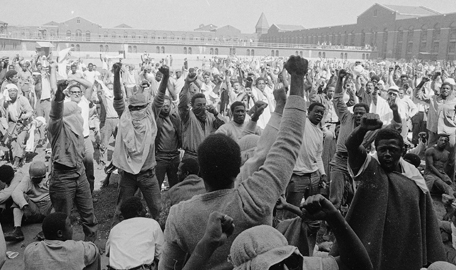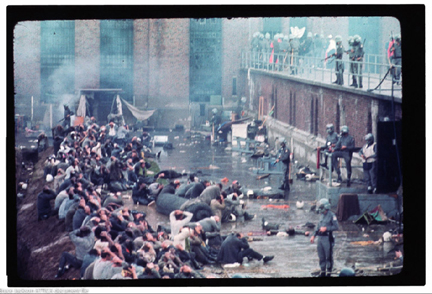
CDCR Responds with More Group Punishment, Isolation, and Gang Charges

petty actions
have been approved according to a memo from the CDCR.
The bourgeois press has been repeating the CDCR’s ridiculous claim that if prisoners went on strike again it might delay reforms in the SHU system. Their audacity is laughable. We all know the strike is nothing but a scapegoat, and not the cause of their “delay.”
Meanwhile, they have indicated that they will make conditions worse on three main points of the original Five Core Demands. All three points address the systematic repressiveness of the whole California prison system.
-
MORE GROUP PUNISHMENT - Not only has the CDCR threatened that reforms
will be slowed down by another round of hunger striking, but they have
implied that non-striking prisoners will also lose their programming as
a result.(1) This is in direct contradiction to the first demand.
-
MORE SECURITY THREAT GROUPS - While the prisoners have demanded an end
to the arbitrary and secretive system of giving people endless sentences
in the Security Housing Units (SHU, long-term isolation) for “gang
affiliation,” the CDCR has publicly discussed broadening the “Security
Threat Group” category to include street organizations. This will mean
more people in SHU for indeterminate sentences.
-
MORE LONG-TERM ISOLATION - The third demand calls for an end to the
torturous practice of long-term isolation. While the state has continued
to assert that these practices are constitutional based on court
rulings, they have promised to send more prisoners to Administrative
Segregation and SHU just for participating in the hunger strike!
As laid out in the Five Core Demands, these are parts of a system of oppression that affects all prisoners. While comrades in SHU have the drive to put it down hardest because of their living conditions, the CDCR is making it clear that the implications will affect the whole system.
Even the reforms offered in the Gang Management Policy Proposal of 25 August 2011 allow the continued practice of keeping the most progressive and politically active prisoners in isolation indefinitely.(2) While this would put California more in line with what is done in most other parts of the country, it is hardly progress. This proposal highlights the political nature of the injustice system.
Even the Eight Short-term Action Items affecting prisoners in Security Housing Units listed in a 27 September 2011 CDCR memo(3) may not be granted to prisoners refusing to eat state-issued meals. They hope that by granting the more petty demands that they can break up the unity of California prisoners, convincing some to give up while they are ahead. The unreasonable actions of the CDCR during this whole conflict should convince any prisoner that such a move would be a mistake. There is no indication that California will be reducing its repression, and every indication that it hopes to heighten Amerika’s war on oppressed nations.
State of California
Memorandum
Date September 27, 2011
To All CDCR Inmates
Department of Corrections and Rehabilitation
Subject- INMATE PROGRAMMING EXPECTATIONS RELATIVE TO HUNGER STRIKES
Information has been received that a number. of inmates have engaged in behavior consistent with initiating a demonstration/hunger strike event. The Department will not condone organized inmate disturbances. Participation in mass disturbances, such as hunger strikes or work stoppage will result in the Department taking the following action:
Inmates participating will receive disciplinary action in accordance with the California Code of Regulations.
Inmates identified as leading the disturbance will be subject to removal from general population and placed in an Administrative Segregation Unit.
In the event of a mass hunger strike, additional measures may be taken to more effectively monitor and manage the participating inmates’ involvement and their food/nutrition intake, including the possible removal of canteen items from participating inmates.
All inmates are encouraged to continue with positive programming and to not participate in this or any other identified mass strike/disturbance. These types of disturbances impact inmate programming and day-to-day prison operations for the entire population. While every effort will be made to continue normal programming for nonparticipating inmates, a large scale disturbance of this type will unavoidably impact operations. The Department will notify inmates and families when and if normal programming is impacted.
SCOTT KERNAN Undersecretary (A), Operations
cc: Terri McDonald George J. Giurbino R. J. Subia Kelly Harrington Tony Chaus Wardens
State of California
Department of Corrections and Rehabilitation
Memorandum
Date : September 27, 2011
To : All CDCR Inmates
Subject: REVIEW OF SECURITY HOUSING UNIT AND GANG POLICIES
In May 2011 the Department began the complex process of assessing the policies and procedures associated with the Gang Validation Process, Indeterminate Gang Security Housing Unit (SHU) Program, as well as privileges associated with inmates on Indeterminate SHU status. The purpose of the review is to improve our policies by adopting national standards in gang/disruptive group management. Before commencing this review, the Department received input from internal and external experts, other state and federal correctional systems, inmates, and other stakeholders While the process of policy review and change will take several more stakeholders to implement, much has already been done. In fact, a draft of the new policy should be ready for stakeholder review next month. In addition, several changes have already been made by the Department, including:
Short-term Action Items:
-
Authorization of watch caps for purchase and State issue. Authorization
of wall calendars for purchase in canteen.
-
Authorization of exercise equipment in SHU yards (installation of
permanent dip/push-up bars is still under review).
-
Authorization of annual photographs for disciplinary free inmates.
Approval of proctors for college examinations.
-
Use of California Department of Corrections and Rehabilitation’s (CDCR)
Ombudsman for monitoring and auditing of food services.
-
Authorization of sweat pants for purchase/annual package.
-
Authorization of Hobby items (colored chalk, pen fillers, and drawing
paper).
Mid-term Action Items:
As noted above, the Department is conducting a comprehensive review of SHU policies that includes behavior-based components, increased privileges based upon disciplinary free behavior, a step down process for SHU inmates, and a system that better defines and weighs necessary points in the validation process. The initial policies will be completed shortly and upon Secretary approval will be sent for stakeholder review and comment. Upon receipt of this input, the Department will initiate any regulation changes in the administrative law process necessary and implement the first major changes to the validation process in the last two decades. Of course this work may be delayed by large-scale inmate disturbances or other emergency circumstances.
SCOTT KERNAN Undersecretary (A), Operations
cc: Terri McDonald George J. Giurbino R. J. Subia Kelly Harrington Tony Chaus Wardens
Campaign info:
California Strike Against Torture in Prisons - 8 July 2013
Related Articles:This article referenced in:












